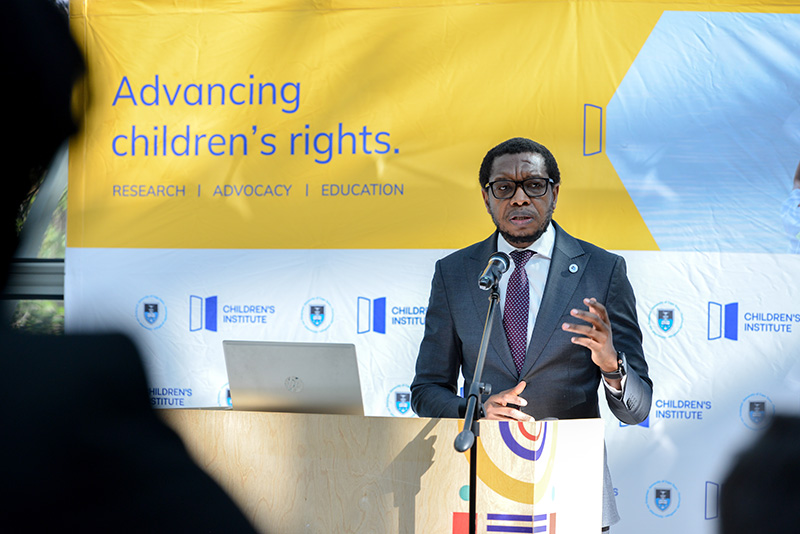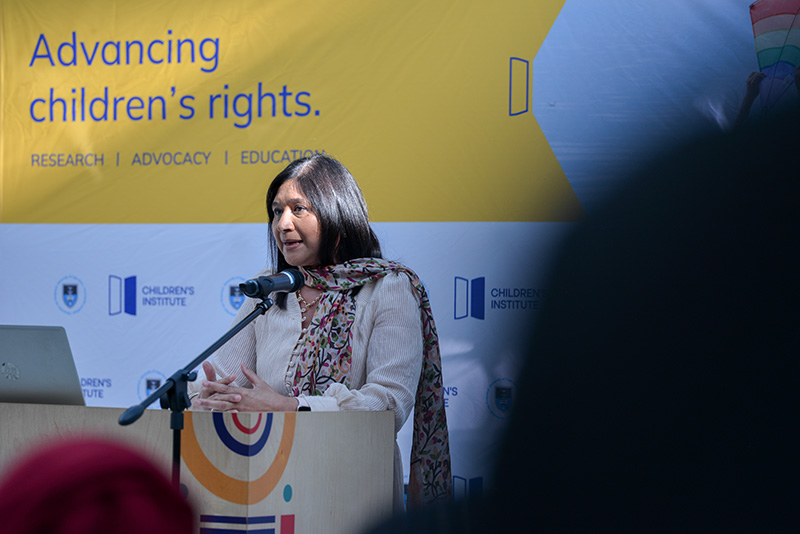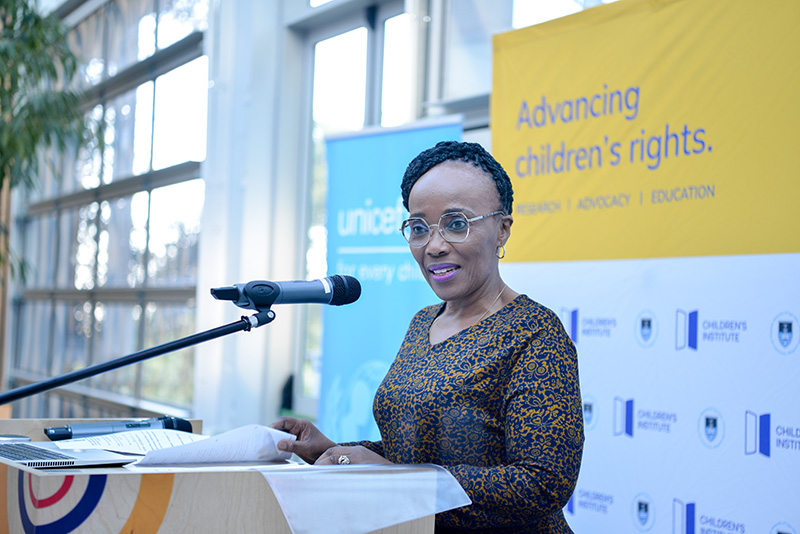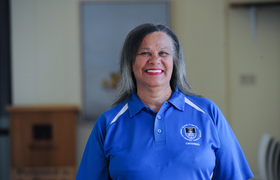UCT, partners urge united action to break cycles of violence
14 November 2025 | Story Lyndon Julius. Photos Katherine Rainers. Read time 10 min.The launch of the South African Child Gauge 2025, hailed as “a vital compass for public policy and social justice”, brought together researchers, policy makers, funders and activists in a united call to end violence against women and children.
The annual publication by the University of Cape Town’s (UCT) Children’s Institute, launched at the Hasso Plattner School of Design Thinking Afrika (d-School Afrika), focuses this year on the theme “Intersections of violence against women and children: disrupting intergenerational harm”. It emphasises how these forms of violence are connected, how they echo across generations, and what collective action is needed to break the cycle.
Opening the event, Professor Tracy Naledi, the deputy dean in UCT’s Faculty of Health Sciences and chair of the Children’s Institute Advisory Board, said the publication had become a vital compass for public policy and social justice.
“The Child Gauge is one of the most trusted sources of evidence on children’s lives,” she noted. “Each year, it helps us act on the challenges facing children. This year’s theme asks us to confront how harm travels through generations, and to imagine systems of care, safety and justice that can finally break those cycles.”
A moral challenge
UCT Vice-Chancellor Professor Mosa Moshabela welcomed guests, describing the publication as both a milestone and a moral challenge.
“This is not only a launch; it’s a call to action,” he said. “The Child Gauge looks at the intersection between women and children, the mother–child dyad, which we often overlook because it’s complex. But we must embrace that complexity rather than shy away from it.”
He warned that violence is not a single event, but “an ecosystem of harm” that society must confront collectively.

“When a young man becomes a perpetrator, it did not start in that moment. Society has created an environment where other forms of violence are normalised. The Child Gauge begins to address that by urging us to adopt frameworks that see the whole system.”
Speaking on behalf of UNICEF South Africa, deputy representative Irfan Akhtar stressed that the intergenerational cycle of violence is a global crisis, with local consequences.
“Everywhere we go, we see this pattern repeat. In South Africa, every day, 22 children are violently attacked, and three are killed. Forty percent of reported sexual offences in 2022–2023 were against children.”
Breaking the cycle
He added: “Breaking the cycle means empowering parents, caregivers and communities with the skills to create a circle of protection around children. Prevention is the cornerstone of effective child protection.”
Professor Shanaaz Mathews, editor of the 2025 Child Gauge and evaluation lead for What Works to Prevent Violence Against Women and Girls, unpacked the evidence linking violence against women and children.

“Policy on its own is not enough to protect women and children,” she said. “These forms of violence often co-occur in the same households, and share risk factors rooted in gender inequality and social norms that justify control through violence.”
She added: “For girls, exposure to violence often leads to depression and re-victimisation; for boys, it can lead to aggression and risk-taking. To break these cycles, we need gender-transformative, trauma-informed approaches that address the family as a whole.”
Lucy Jamieson, senior researcher and South African Child Gauge editor, argued that prevention must begin “from conception onwards”.
“Early and consistent support during the first 1 000 days of life can disrupt cycles of abuse,” she said. “But interventions must extend across homes, schools and communities. We need a whole-of-society approach.”
Jamieson called for greater coordination among health, education and social development services.
Siloed services
“Women and children often fall through the cracks because services are designed in silos. To truly protect them, we must integrate systems, share data and build trust between professionals.”
Dr Linda Ncube-Nkomo, the chief executive officer of the Nelson Mandela Children’s Fund, reminded guests that violence is not confined to policy documents, but lived daily by families.
“Violence against women is violence against children,” she said. “If we don’t stop that tap of violence, generations will grow up believing it’s normal.”
She emphasised the dual role that schools have to play.
“Schools can interrupt cycles of harm by embedding trauma-informed approaches and supporting teachers who may themselves be survivors. Real change starts in communities, because children don’t live in governments – they live in homes.”
Delivering the keynote address, Minister in the Presidency for Women, Youth and Persons with Disabilities Sindisiwe Chikunga described violence as “a national emergency written in the lives of those we fail to protect”.

“Violence is rarely confined to one person or one generation,” she said. “The trauma of a mother spills into her child’s life; the suffering of a child echoes through the household and community. Our duty is to make the whole system child-safe.”
Women empowerment
She highlighted counter-measures, including stricter vetting in schools, expanded trauma services and economic empowerment for women.
“Protection must come with economic power,” Chikunga said. “When mothers can earn, predators lose power and impossible choices fall away. Until every child is free from fear, none of us can claim to be free.”
Closing the event, Associate Professor Wiedaad Slemming, the director of the Children’s Institute, thanked the contributors and reaffirmed the institute’s mission.
“Like every Child Gauge, this one took a village,” she said. “Our shared goal is to turn evidence into action and ensure that no woman or child falls through the cracks.
“The Child Gauge embodies UCT’s mission to generate knowledge that transforms society. By working together across disciplines and sectors, we can build a future where every child grows up safe, supported and free to thrive.”
 This work is licensed under a Creative Commons Attribution-NoDerivatives 4.0 International License.
This work is licensed under a Creative Commons Attribution-NoDerivatives 4.0 International License.
Please view the republishing articles page for more information.
















